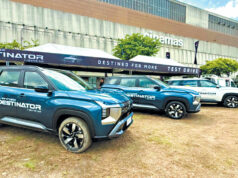AS Mitsubishi Motors prepares to launch a heavily refreshed pickup truck model later this year, the company is hyping its four decades of experience in building such vehicles. It cited in particular the introduction in 1978 of its L200 one-ton pickup (called Forte in some markets), a model the company said has served millions of people over the next four decades.
Designed to carry a load of up to one ton, the L200, from the beginning, was pitched to have combined the ease with which a car can be driven with the rugged, useful features for which pickups are known. Two years after launch, Mitsubishi fitted the L200 with a four-wheel drive train, in the process laying the foundation for the succeeding Pajero/Montero SUV and the Delica vans.
The second generation of the L200, launched in 1986, and which eventually came to be called Triton and Strada in certain markets, continued on the success of the original. For the first time the truck came in single cab, club cab (a small space behind the seats were added) and double cab (it came with a backseat and rear doors), as well as in gasoline and diesel engines. The third-generation model, built between 1995 and 2005, followed on the formula of the previous truck, although getting an advanced four-wheel drive system whose 4WD mode can be engaged more easily.
According to Mitsubishi, such was the success of the first two model generations of the L200 that by the time the third was launched, in 1995, the company shifted the pickup’s production from its plant in Ohe, Japan, to Laem Chabang in Thailand. This plant, now Mitsubishi Motors’ biggest factory with an annual capacity of around 400,000 vehicles, is from where the L200 (or Triton or Strada) is exported worldwide.
In August 2005 Mitsubishi brought out the fourth-generation L200, then more commonly known either as the Triton or Strada. It came in the same body configurations, but had new 2.5-liter and 3.2-liter common-rail diesel engines, as well as the updated Super Select 4WD system. Like its predecessor the model was sold for nearly 10 years, getting replaced in November 2014 by the fifth-generation model, which saw the introduction of new 2.4-liter MIVEC turbocharged “clean” diesel, 2.5-liter turbocharged diesel, and 2.4-liter gasoline engines, as well as new six-speed manual and five-speed automatic transmissions. The four-wheel drive mode selector, now called Super Select 4WD-II, adopted an electronic actuator.
It is expected that most of these features will make it to the upcoming model with varying degrees of improvements; for example, a new eight-speed transmission is a possible upgrade, given that this gearbox is now available in Mitsubishi SUVs. What is more certain is that the new pickup will subscribe to the brand’s present design language that’s marked by aggressive, angular lines that mimic the look of the Montero Sport. In any case, the wait for the updated model will soon be over.



